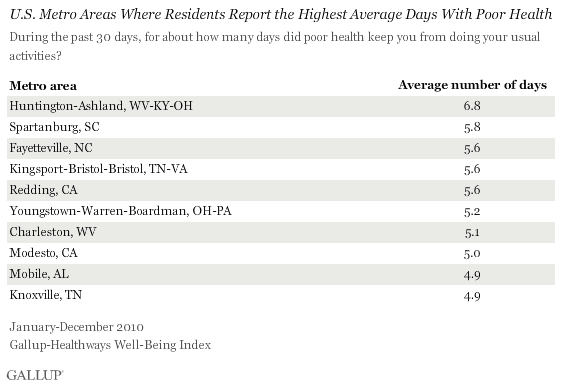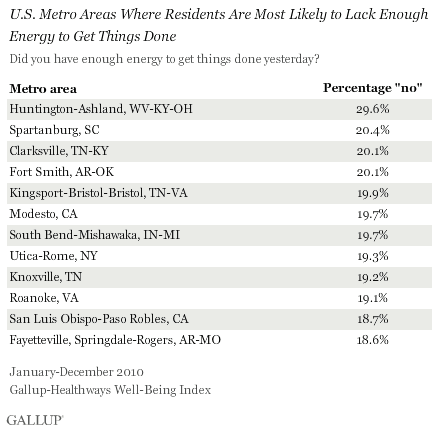WASHINGTON, D.C. -- About one in three residents living in the Huntington-Ashland, W.Va.-Ky.-Ohio metropolitan area (32.1%) say they have been diagnosed with depression by a doctor or nurse -- the highest percentage among the 188 U.S. metropolitan statistical areas (MSAs) that Gallup and Healthways surveyed in 2010. Of the 11 metro areas where residents are most likely to say they had ever been diagnosed with depression, 6 are in the Appalachian region: Along with Huntington-Ashland are Charleston, W.Va; Knoxville, Tenn.; Kingsport-Bristol-Bristol, Tenn.-Va.; Spartanburg, S.C.; and Roanoke, Va.

It's well-documented that poor economic conditions can increase the incidence of stress and mental health problems in a population, which can in turn hamper productivity. This negative cycle may also lead to lower well-being among many Americans, as Appalachian communities seem predisposed to a combination of economic and psychological depression.
Depression Linked to Underproductive Days, Low Energy
Another finding from the Gallup-Healthways Well-Being Index 2010 data clearly reflects the link between mental health and personal productivity: Respondents who have been diagnosed with depression report a high number of days in the past month when poor health kept them from doing their usual activities. Depression is more strongly related to unhealthy days than any other specific health condition asked about, including high blood pressure, diabetes, and asthma. Thus, several of the communities on the list of metro areas where diagnosis of depression is most common -- including those in the Appalachian region -- are also among those with the highest average number of unhealthy days among the 188 U.S. cities surveyed last year.

Three of the same communities -- Huntington-Ashland, Kingsport-Bristol-Bristol, and Knoxville -- are also among the U.S. metro areas where residents are most likely to say they didn't have enough energy to get things done the previous day. Two other Appalachian communities -- Spartanburg, S.C., and Roanoke, Va. -- join them on this list.

Huntington-Ashland
The Huntington-Ashland metro area is particularly noteworthy for its results: Not only do one-third of adult residents say they have been diagnosed with depression, but they also report an average of almost 7 days in the past 30 when poor health kept them from their usual activities. Huntington-Ashland is also high on the list of cities with the highest percentages of obese residents, and ranked near the bottom of the Gallup-Healthways Well-Being Index for 2010. These results correspond with prior assessments of health and well-being in the Huntington-Ashland community. A 2008 report from the U.S. Centers for Disease Control and Prevention ranked the Huntington-Ashland metro area as the least healthy in the country, based largely on annual state-level surveys.
Implications
The Appalachian region's economic woes must be addressed with efforts to attract new industries to many communities where manufacturing, mining, and forestry jobs have dried up. However, the 2010 Gallup-Healthways Well-Being Index findings imply that for many communities in the region, poor psychological health may be a significant barrier to growth. New organizations might hesitate to establish operations in a region where energetic, highly productive employees are hard to find.
Community leaders may find that investments in initiatives to improve residents' physical and psychological well-being are needed in tandem with economic strategies to turn the current negative mindset around and establish a positive cycle of optimism and growth. Such initiatives might include public health efforts to improve nutrition and increase physical activity -- outcomes that have the potential to elevate residents' physical and psychological health. In places like Huntington-Ashland, soaring rates of depression may need to be directly addressed through public education campaigns and strategies for promoting high levels of collaboration between primary care physicians, mental health professionals, and substance abuse programs.
About the Gallup-Healthways Well-Being Index
The Gallup-Healthways Well-Being Index tracks U.S. and U.K. well-being and provides best-in-class solutions for a healthier world. To learn more, please visit well-beingindex.com.
Survey Methods
Results are based on telephone interviews conducted as part of the Gallup-Healthways Well-Being Index survey Jan. 2-Dec. 29, 2010, with a random sample of 245,817 adults, aged 18 and older, living in reportable Metropolitan Statistical Areas (MSAs) in all 50 U.S. states and the District of Columbia, selected using random-digit-dial sampling.
Metro areas in this article are based on the MSAs as defined by the U.S. Office of Management and Budget. In many cases, more than one city is included in the same MSA. The San Jose, Calif., MSA, for example, also includes the smaller nearby cities of Sunnyvale and Santa Clara in addition to San Jose itself. Each respondent is attributed to his or her MSA based on the self-report of his or her ZIP code. Gallup reports data for MSAs for which there were at least 300 completed interviews in 2010. A total of 188 MSAs met this criterion, which generally incorporates the larger MSAs according to population size.
Maximum expected error ranges for the MSAs vary according to size, ranging from less than 1 percentage point for the largest cities represented to ±6.5 percentage points for the smallest cities.
Interviews are conducted with respondents on landline telephones and cellular phones, with interviews conducted in Spanish for respondents who are primarily Spanish-speaking. Each sample includes a minimum quota of 400 cell phone respondents and 600 landline respondents per 1,000 national adults, with additional minimum quotas among landline respondents for gender within region. Landline telephone numbers are chosen at random among listed telephone numbers. Cell phone numbers are selected using random-digit-dial methods. Landline respondents are chosen at random within each household on the basis of which member had the most recent birthday.
Samples are weighted by gender, age, race, Hispanic ethnicity, education, region, adults in the household, and phone status (cell phone only/landline only/both, cell phone mostly, and having an unlisted landline number). Demographic weighting targets are based on the March 2010 Current Population Survey figures for the aged 18 and older non-institutionalized population living in U.S. telephone households. All reported margins of sampling error include the computed design effects for weighting and sample design.
In addition to sampling error, question wording and practical difficulties in conducting surveys can introduce error or bias into the findings of public opinion polls.
For more details on Gallup's polling methodology, visit https://www.gallup.com/.
